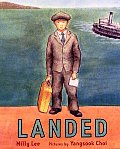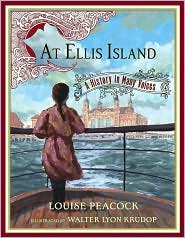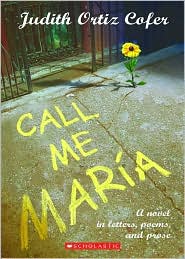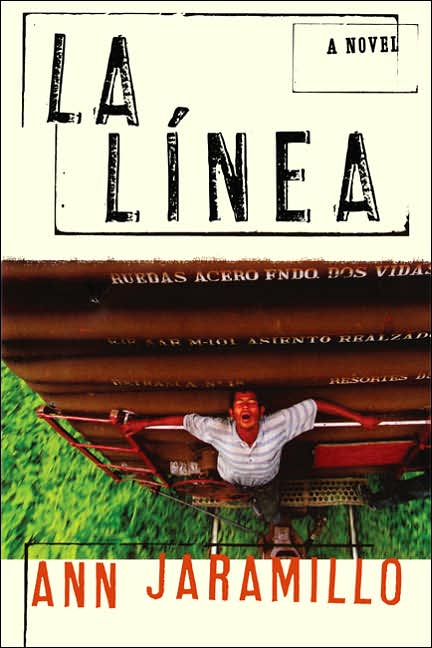By Tami Morton, Lois Knezek, & Betty Reily, University of North Texas, Denton, TX
Children’s and adolescent literature is a wonderful starting place for young readers to begin considering and understanding experiences of immigration to the United States. Many talented authors have provided characters with whom many children and young adults can relate.
 Milly Lee (2006) introduces readers to Sun Lee, a 12-year old Chinese boy, who immigrates to America in the book Landed. Sun’s parents believe that there are more opportunities for him in the United States, so they prepare him for his departure. Though Sun is a bit nervous, he knows that his older brothers went to America once they reached the age of 12, so he was ready and willing to make the trek. Sun’s immigration to America was totally voluntary. In the story, the description of Sun’s preparation, traveling experiences, as well as the extended time he remained at Angel Island before he officially “lands,” were a testament to bravery. It was clear at the end of the story that Sun really was happy and proud to be in the United States. Though this story took place in the 1930’s, it provides readers an opportunity to think critically about the entrance of Chinese people who wanted to come to America.
Milly Lee (2006) introduces readers to Sun Lee, a 12-year old Chinese boy, who immigrates to America in the book Landed. Sun’s parents believe that there are more opportunities for him in the United States, so they prepare him for his departure. Though Sun is a bit nervous, he knows that his older brothers went to America once they reached the age of 12, so he was ready and willing to make the trek. Sun’s immigration to America was totally voluntary. In the story, the description of Sun’s preparation, traveling experiences, as well as the extended time he remained at Angel Island before he officially “lands,” were a testament to bravery. It was clear at the end of the story that Sun really was happy and proud to be in the United States. Though this story took place in the 1930’s, it provides readers an opportunity to think critically about the entrance of Chinese people who wanted to come to America.
 In Immigrant Girl: Becky of Eldridge Street by Brett Harvey (1987), young readers are provided an image of a 10-year-old immigrant girl who has just moved to America from Grodno, Russia. Becky explains that her family came to America to avoid the “terrible pogroms in Russia.” The author Brett Harvey includes a glossary at the end of the story that explains that pogroms are “an organized massacre of Jews.” This story provides another opportunity for students to think critically about another culture, Jewish people, and their reasons for coming to America at the beginning of the century. Many stories of the Holocaust offer other insights to the immigration of Jewish people to the United States. This story is another example of a book that discusses immigration from a positive point of view. Becky and her family struggle to make ends meet, yet she and her family are healthy and happy. This picture book gives readers the impression that Becky and her family voluntarily came to the United States to avoid persecution. In the end, they have found America to be the “land of opportunity.”
In Immigrant Girl: Becky of Eldridge Street by Brett Harvey (1987), young readers are provided an image of a 10-year-old immigrant girl who has just moved to America from Grodno, Russia. Becky explains that her family came to America to avoid the “terrible pogroms in Russia.” The author Brett Harvey includes a glossary at the end of the story that explains that pogroms are “an organized massacre of Jews.” This story provides another opportunity for students to think critically about another culture, Jewish people, and their reasons for coming to America at the beginning of the century. Many stories of the Holocaust offer other insights to the immigration of Jewish people to the United States. This story is another example of a book that discusses immigration from a positive point of view. Becky and her family struggle to make ends meet, yet she and her family are healthy and happy. This picture book gives readers the impression that Becky and her family voluntarily came to the United States to avoid persecution. In the end, they have found America to be the “land of opportunity.”
 The multigenre book, At Ellis Island: A History in Many Voices (Peacock, 2007) tells the story of children who were immigrants from Europe coming to America on ship. Many of them came alone. Others were coming to meet family that was already in the United States. Nonetheless, they were all coming to a land where they could feel safe and be prosperous. This book is another example of a text that tells the story of immigrants who came to America voluntarily. All the characters had to be both brave and strong in their trip to Ellis Island, yet when they reached the coast, they were delighted to be in this prosperous country.
The multigenre book, At Ellis Island: A History in Many Voices (Peacock, 2007) tells the story of children who were immigrants from Europe coming to America on ship. Many of them came alone. Others were coming to meet family that was already in the United States. Nonetheless, they were all coming to a land where they could feel safe and be prosperous. This book is another example of a text that tells the story of immigrants who came to America voluntarily. All the characters had to be both brave and strong in their trip to Ellis Island, yet when they reached the coast, they were delighted to be in this prosperous country.
 Call Me María (Cofer, 2004) is a true story of María who is from Puerto Rico, a territory of the United States. This adolescent book tells of the conflict of a teenager who faces the choice of coming to New York to be with her father or to stay in Puerto Rico with her mother. Maria’s mother understands the importance of the good education that Maria would receive in New York, but at the same time she is not happy about being separated from her daughter. Ultimately, Maria moves voluntarily. The author, Judith Cofer, attempts to give an honest depiction of what life is like for those who leave the familiar for the unfamiliar and the challenges that María faced in order to take advantage of educational opportunities.
Call Me María (Cofer, 2004) is a true story of María who is from Puerto Rico, a territory of the United States. This adolescent book tells of the conflict of a teenager who faces the choice of coming to New York to be with her father or to stay in Puerto Rico with her mother. Maria’s mother understands the importance of the good education that Maria would receive in New York, but at the same time she is not happy about being separated from her daughter. Ultimately, Maria moves voluntarily. The author, Judith Cofer, attempts to give an honest depiction of what life is like for those who leave the familiar for the unfamiliar and the challenges that María faced in order to take advantage of educational opportunities.
Overall, the immigrant experience described in these books give an affirmative view on why people come to the United States, however, do they portray the true experience for the majority of immigrants? Do they relate the stories of earlier immigrants in our history as well as recent immigration experiences? Immigration laws and immigration reform is a greatly debated issue in the United States today. McGlinn (2007) explains that the number of immigrants of today are similar to the number who arrived in America in the early part of the 20th century, despite what many people think. “A report describing the foreign-born population of the United States in 2003 (based on data collected by the U.S. Census Bureau in the Current Population Survey) shows that the foreign-born population stands at 11.7%, a number that is very close to the 15% from the earlier immigration influx.” Is the experience the same now as it was then? Is it always a positive experience? Do immigrants ever want to go back to their country of origin? Are these topics explored in literature as well?
 Consider the Africans who were taken from their country of origin to be slaves in the United States. The Middle Passage: White Ships/Black Cargo (Feelings, 1995), often deemed to have too mature content for younger readers, reflects in pictures the horrors of this journey. Slaves who lived through the journey were forced to live here and to work for free—not the “opportunity” that many immigrant books share. Despite the conditions of their arrival, many slaves dealt with their situation with bravery and strength. Sharon Draper in Copper Sun (2006) tells the immigration story of one character beginning with the heartbreaking story of her capture and journey across the Middle Passage and continuing with the harsh life she endures that reveals her strength.
Consider the Africans who were taken from their country of origin to be slaves in the United States. The Middle Passage: White Ships/Black Cargo (Feelings, 1995), often deemed to have too mature content for younger readers, reflects in pictures the horrors of this journey. Slaves who lived through the journey were forced to live here and to work for free—not the “opportunity” that many immigrant books share. Despite the conditions of their arrival, many slaves dealt with their situation with bravery and strength. Sharon Draper in Copper Sun (2006) tells the immigration story of one character beginning with the heartbreaking story of her capture and journey across the Middle Passage and continuing with the harsh life she endures that reveals her strength.
 One similarity across immigration stories is that all immigrant characters in children’s and adolescent literature that come to America, whether voluntarily or involuntarily, meet harsh challenges. There is often a good ending, however it is not without sacrifice that immigrants have realized America as “the land of opportunity” — or do they? (This latter question will be explored in next week’s topic.) Last week’s WOW Currents responses talk about La Línea, an excellent example of challenges faced by certain young immigrants. The young man crossing the border realizes that there are many borders that immigrants must cross. While many books exist that address immigration from many different perspectives, are the challenges presented in the literature ones that are realistic. Do the immigration stories authentically represent for young readers the purposes, countries of origin, and complexities of the journey? We are eager to hear of your perspectives and experiences with similar literature.
One similarity across immigration stories is that all immigrant characters in children’s and adolescent literature that come to America, whether voluntarily or involuntarily, meet harsh challenges. There is often a good ending, however it is not without sacrifice that immigrants have realized America as “the land of opportunity” — or do they? (This latter question will be explored in next week’s topic.) Last week’s WOW Currents responses talk about La Línea, an excellent example of challenges faced by certain young immigrants. The young man crossing the border realizes that there are many borders that immigrants must cross. While many books exist that address immigration from many different perspectives, are the challenges presented in the literature ones that are realistic. Do the immigration stories authentically represent for young readers the purposes, countries of origin, and complexities of the journey? We are eager to hear of your perspectives and experiences with similar literature.
REFERENCE
McGlinn, J.M. (2007). Coming to America: The U.S. immigrant experience. In Hadaway, N.L. & McKenna, M.J. (Eds.) Breaking boundaries with global literature: Celebrating diversity in K-12 Classrooms (73-91). Newark: International Reading Association.
Journey through Worlds of Words during our open reading hours: Monday-Friday, 9 a.m. to 5 p.m. and Saturday, 9 a.m. to 1 p.m. To view our complete offerings of WOW Currents, please visit archival stream.
- Themes: Betty Reily, Immigrant Girl, Janelle Mathis, Landed, Lois Knezek, Tami Morton
- Descriptors: Books & Resources, Debates & Trends, WOW Currents

As my English Language Learners and I read the book, Immigrant Girl: Becky on Eldridge Street we admired her sentiment and her strength to find happiness in her new home while fondly remembering her old one. As Becky revealed her memories of her past life, my students revealed their own memories. When Becky spoke of the adjustments she has had to make in the United States, my students shared their own adjustments and changes. My students wrote stories about their own experiences and composed them into booklets. They had only lived in the United States a little over two years at the time we read Becky’s adventures and discussed the similarities to their own experiences. Listening to the story and being involved in these discussions opened up avenues into the stories each of them held inside. The power of expressing their own words to reveal an inner part of themselves became a dynamic and vital key to allowing their minds to grow and learn throughout the year.
Personally, I find the respective immigrant stories captivating, if not poignant. As I have been doing research with my group, I have been drawn to nonfiction books that framed the immigrant experience in rather stark reality. The black and white photographs captured faces of determination buoyed by hope. The immigrants’ reasons for coming, of course, were as varied as each of the individuals or families who made the United States their destination. Each individual or family, regardless of whether hunger, jobs, or persecution drove them to leave their birth place, searched for a better life. This better life might afford them the opportunity to practice religious freedom, the ability to own land, the prospect of a job, or the excitement of adventure. The harsh realities of a new land where they did not know the language, customs, or how to navigate the system were softened somewhat by organizations such as the Red Cross, the Salvation Army, and sponsor families, if the immigrants had no family already in America.
Immigrants referred to America in a variety of ways. Some called it the “Golden Land,” even though gold was not strewn on the streets for the taking. Others called it “The Promised Land,” referencing the Exodus destination of the Children of Israel. However the immigrants looked upon this country that opened its doors, many would agree that “the United States is the best place in the world for making dreams come true” (Ashabranner, 1993, p. 109).
Ashabranner, B. (1993). “Still a nation of immigrants.”
New York: Cobblehill Books/Dutton.
Jacobs, W.J. (1990). “Ellis Island: New hope in a new
land.” New York: Charles Scribner’s Sons.
Jango-Cohen, J. (2005). “Ellis Island.” New York:
Children’s Press.
Levine, E. (1993). “…If your name was changed at Ellis
Island.” New York: Scholastic, Inc.
The Middle Passage is an interesting choice for immigration in that is shows an entirely different version – one without such opportunity as the motivation. Since it carries content considered more mature, I wonder if it could be a good pairing for older adolescents reading Ellison’s Invisible Man. Possibly The Middle Passage could give some insight into the beginnings of some stereotypes formed.
When a group of people is labeled as immigrants, certain social attitudes and assumptions are promptly attached. The connotation attached to immigration is briefly reflected through the book covers listed in this blog too. Some of the book cover images remind me of Allen Say’s Grandfather’s Journey (1993). In Grandfather’s Journey, a well-dressed man stands on the deck of a ship. He is pushing hard his hat down with his both hands. His flipping coat edge signals that wind blows strong or the ship moves fast. The dark color of the ocean behind him tells us he is in the middle of a long journey. The immigration stories signal their immigrant-ness visually and textually. Visual symbols tend to carry the medium of immigration to the U.S. such as ships, aircrafts, airport and the ocean. In my study of Korean-American (mis)representation in picture books, airplane and airport were the symbolic icons of new wave of Korean immigrants. The textual symbols for immigration literature are often found in the book titles. Sometimes it is protagonist’s non-Anglo name or more straightforward of saying ‘Ellis Island’ or ‘immigrant’. While Landed shows the character’s after arrival status in the book cover, At Ellis Island and The Middle Passage show the direction of the ship is heading to the U.S because their back is what the readers are seeing on the cover. Call me María also carries a tone of introducing saying, “ Hi, I am new. My name is Maria”. Within 24 Korean-American picture books, only 6 books are not about immigration even though it has been several years since Korean-Americans celebrated their 100th immigration anniversary. Other books contain textual indications through Korean’s name or language such as Halmoni, Juno, Ae-kyung, Yoon, Good-bye Shin Dang Dong 382, and Korean bilingual titles.
The issues with immigrants portrayed children’s literature are overrepresentation of being new. In other words, the act of moving to the U.S. and following struggles for adjustment and acculturation are highly emphasized through a wide range of historical contexts from 1930’s to present. However, the sequence of immigration or contemporary visa holders living in the U.S. experiences are underrepresented comparing to the new immigrants experience. This overrepresentation of newness to the U.S. construct the social attitudes and mind-set that immigrants as ‘you are not from here’ or non-Americans within the U.S. The book like La Línea is almost the consequence of the historically constructed social attitudes of ‘ you are not from here’. Recent observation that the word of ‘immigration’ has often the association with ‘illegality’ is an extreme example of undesired social mind-set toward immigrants– disadvantageous group to the ‘real’ Americans originated from ‘here’. In Korean-American picture books, the otherness were embedded through the forever foreigner images of immigrants through far-away, villages, English language barrier, and overrepresented Koreans social status. The depictions of Korean-Americans are also reflected through other cultural groups who have the longer immigration history in the U.S. such as Chinese and Japanese. The Koreanness are defined through the assimilated images of Asianness and the Asian-ness couldn’t be separated from the social attitudes toward immigrants who are forever new and different from the mainstream whatever that means. That’s why five Korean-American jobs among six Korean- Americans career portrayed in the picture books are food related jobs such as grocery owner, tofu factory owner, and vendor owner the jobs. Overrepresenting immigrants’ experiences can mislead readers and the mind-set of ‘ you are not from here’ will not go away but grows. The cultural aspects and the origin of a cultural group are significant parts of understanding of immigrants experiences, however, it should be a continuing exploration inquiring what happens to the Chinese people who landed in 1930’s. It may be worth exploring whether we have immigrants who are still landing and what happened since 1930 to now after they landed the U.S.
I agree with the fact that public policy has set negative connotations on the words “immigrant” and “illegal” – at least to some degree. Consequently, leaving another country to find an “American Dream” as we have been labeled does not represent the true experiences immigrants will encounter. What immigration was 60 years ago is not the same as it is today. The acculturation and assimilation processes themselves that immigrants go through are a rude awakening in a sense that they [immigrants] are not aware of attitudes and challenges they will face in being an immigrant to a new country. The utilization of children’s literature is crucial in building critical literacy and the appreciation of multicultural societies. This, coupled with the authenticity of publications, will help depict a more realistic picture of immigrants’ experiences.
Has anyone else read Denied, Detained, Deported: Stories from the Dark Side of American Immigration by Ann Bausam? I’ve almost finished this and am do drawn in by the various stories that span across many years of immigration and point to many issues that kept out many who came to our country to become part of its social structure. It speaks of Holocaust survivors being refused and the exploitation of Mexican workers. At a time when we are so concerned from a national security perspective, these stories address instances in the past where the causes for refusal of entry was not based on sound rationale. It is a powerful multiple perspective look at immigration.